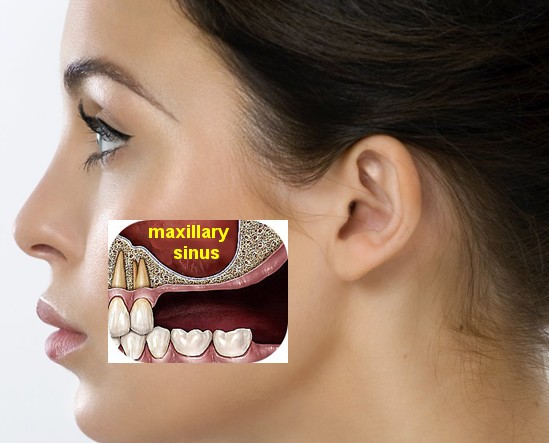Compiled by Walter Sorochan
Posted August 24, 2012 Updated October 17, 2021; Disclaimer
|
Update Sept 30, 2015: Oral health is the most overlooked health issue in conventional and integrative medicine:
"The issue of bone loss after tooth loss has been ignored in the past by traditional dentistry. [according to Skinner] This is so because dentistry had no treatment to stop or prevent the process of bone loss and its consequences. As a result, doctors had to ignore the inevitable bone loss after tooth extraction. Today, the profession knows about bone loss and that implants [ if done at proper time ] can stop bone loss because implants stimulate the bone, similar to the way the tooth did prior to its loss." Skinner article no longer active. |
The statistics on tooth loss are a bit staggering: 7 out of 10 adults age 35 to 44 have lost at least one tooth and a quarter of those aged 65 or older [or about 20 million people] have lost all their permanent teeth. Hill: stem cells grow new teeth 2012 There are numerous dental controversies, for example --- whether fluoridation is really effective in preventing dental caries. Many other issues about dentistry are not discussed. Fortunately, there are new developments in dentistry that may help all of us to deal with our dental problems.
|
"The next stem cell advance I expect is the availability of “regenerative dental kits,” which will give dentists the ability to deliver stem cell therapies in their own office. The delivery of stem cell therapies by the dentist is complicated, and these kits will simplify the process and make the treatment more affordable." Murray: latest dental stem cell 2012 |
Many dentists are not explaining the silent issues in dentistry today to their patients! Some dentists are not up to date on the new developments in dentistry. Even though all the hype about how brushing, flossing and cleaning teeth every six months to stop dental caries is good, it does not replace the information you need to know about missing teeth, how your jaw bones work and how to keep your teeth and jaw bones healthy. The new info about dentistry today is how teeth and implants can keep your jaw bones healthy!
The author decided to research about the consequences of missing teeth. Here is what your dentist may not share with you about teeth in general.
Normal jaw bone function: Teeth stimulate the jaw bone to maintain good health. Keeping your jaw bones healthy is probably more important than keeping your teeth clean.
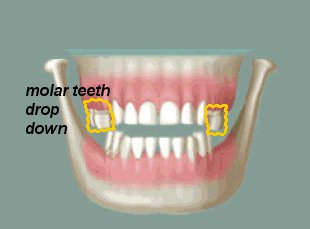 When a tooth is lost, the lack of stimulation causes loss of the jaw bone.
Whenever a tooth is extracted, nature will remove the bone that used to surround
it. Teeth on either side will shift or tip into the empty space.[ orange
rectangle around upper molar teeth in diagram ] If there is a tooth directly above or below the space it will over erupt, as there will not be anything to prevent it from coming out of the gum tissue. The majority of bone degeneration will occur within the first six months but will slowly continue for years. The movement of the adjacent teeth will not occur immediately; rather it will become noticeable after three to five years. How fast it occurs will depend on the density of bone in the area, your bite and how well your teeth occlude or interlock with each other.
If you have missing teeth and you do not replace them, these movements will occur.
When a tooth is lost, the lack of stimulation causes loss of the jaw bone.
Whenever a tooth is extracted, nature will remove the bone that used to surround
it. Teeth on either side will shift or tip into the empty space.[ orange
rectangle around upper molar teeth in diagram ] If there is a tooth directly above or below the space it will over erupt, as there will not be anything to prevent it from coming out of the gum tissue. The majority of bone degeneration will occur within the first six months but will slowly continue for years. The movement of the adjacent teeth will not occur immediately; rather it will become noticeable after three to five years. How fast it occurs will depend on the density of bone in the area, your bite and how well your teeth occlude or interlock with each other.
If you have missing teeth and you do not replace them, these movements will occur.
These movements may create gum problems and /or decay and could lead to the loss of other teeth. As you lose more teeth, you will be forced to chew in other areas, and this often leads to tooth fracture from overloading, excessive wear and/or TMJ (jaw joint) problems. Eventually more extensive and expensive dentistry may be required in the future. Bhanumathi: consquences missing teeth
Thus, when a tooth is extracted from a young person, by the time that person is middle aged, a great deal of bone will be missing. Did your dentist tell you this?
Have your dentist discuss your 'fix' options when you have a sore tooth: e.g.
- extract or pull the tooth --- you lose a tooth
- prescribe an antibiotic
- do a root canal --- drain the pus and save a good tooth
Toothaches: Common dental causes of toothaches include dental cavities, dental abscess, gum disease, irritation of the tooth root, cracked tooth syndrome, temporomandibular joint [TMJ] disorders, impaction, and eruption.
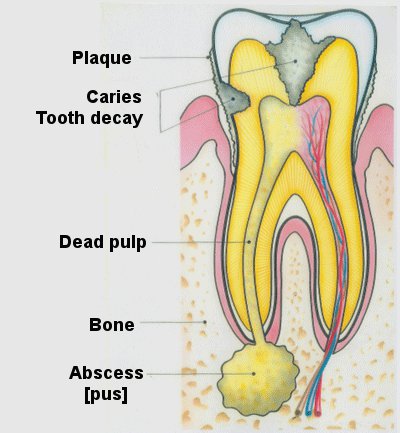
The most common cause of a toothache is a dental cavity or carie. [ Refer to above diagram ] Dental cavities or caries are holes in the two outer layers of a tooth called the enamel and the dentin. Small, shallow cavities may not cause pain and may be unnoticed by the patient. The larger deeper cavities can be painful and collect food debris. The inner living pulp of the affected tooth can become irritated by bacterial toxins or by foods and liquids that are cold, hot, sour, or sweet, thereby causing toothaches. Severe injury to the pulp can lead to the death of pulp tissue, resulting in tooth infection, also referred to as dental abscess.
A tooth abscess, also known as root abscess, is a collection of pus that results from bacterial infection. The infection starts with the soft pulp of the tooth and becomes more severe finally leading to pus formation at the bottom of the tooth root.
Saving teeth with crowns and root canals: Saving teeth is what a dentist does best! Treatment of a small and shallow cavity usually involves a dental filling. Treatment of a larger cavity involves an onlay or crown. Treatment for a cavity that has penetrated and injured the pulp or for an infected tooth is either a root canal procedure or extraction of the affected tooth. The root canal procedure may involve draining the pus, removing the dying pulp tissue and replacing it with an inert filling material. The procedure is used in an attempt to save the dying tooth from extraction. You should be aware that root canals may not last a long time.
The only alternative to a root canal procedure is having the tooth extracted and replaced with a bridge, implant, or removable partial denture to restore chewing function and prevent adjacent teeth from shifting. WebMD: root canals
Fixing cavities and infected teeth requires that a dentist use a local anesthetic to numb your tooth and jaw bone. There is now controversy about the safety of local anesthetics like novocaine or provaine. Stockton: 2004
It is normal procedure for a dentist to numb the jaw - tooth area before working on a painful tooth. He injects a local anesthetic that numbs the jaw-tooth area. The numbness normally wears off in about two to three hours. Sometimes the numbness can last for several days and even months. This prolonged numbness can occur when the needle passes through a nerve in the area of injection and damages a nerve. This complication of numbness is referred to as paresthesia. Garisto: Paresthesia 2011
Bone Resorption: Missing teeth cause changes in the jaw bone structure. The bone that supported the missing teeth begins to shrink or thin away. There is a loss of width and height of the jaw bone. The process is referred to as bone resorption. This is a natural process of your body saving bone nutrients and structure it is no longer using. Jaw bone loss happens most rapidly during the first year of tooth loss and is four times greater in the lower jaw than in the upper. Uditsky article no longer active. The images below help to illustrate this process:
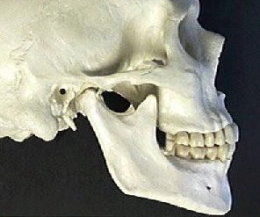 |
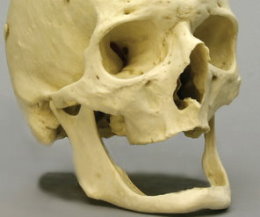 |
| Skull & jaw bone young person | Skull & jaw bone elderly person |
"Both skulls above are real. The one on the right belonged to an elderly person who lost his teeth many years before he died. When he was young and he had teeth, his skull used to look like the one on the left. The first thing that jumps out at you is how thin the bone of his lower jaw is in comparison to the bone on the lower jaw of the skull on the left. But another thing that is not so apparent is the loss of the bone in the upper jaw.
Notice that both skulls are positioned with their lower jaws mounted so that the bone of the lower jaw is about parallel with the bone of the upper jaws. This tells you that the teeth are together. Even the skull on the right---if it had teeth. This gives you an idea of the amount of bone that that has been lost since this man had all his teeth extracted." Spiller: Bone Resorption
Most of us, 70%, have at least one tooth missing and have never had it replaced. Misch: consequences losing teeth 2011 A vast majority do not suffer major problems like eating, speaking or the way they look. On the other hand, a few, especially some women, tend to develop the joint problems, headaches, neck aches or ear aches typical of jaw joint or TemporoMandibular Joint [TMJ]. When a tooth is lost, the lack of stimulation causes loss of the jaw bone. There is a 25% decrease in width of jaw bone during the first year after tooth loss and an overall 4 millimeters decrease in height over the next few years. Misch: consequences losing teeth 2011
One Lost Tooth Causes a Chain Reaction:
The loss of a single tooth starts a chain reaction in the jaw bone. After a back molar tooth is lost, a series of destructive events occur including the shifting of other teeth, decay, tilt, drift and gum pocket formation. Eventually, bone loss and periodontal disease will cause further destruction. If you fail to replace a lost tooth in the back of your jaw, you could eventually lose all your teeth. Dentist Steinberg explains how this can happen in his article: Replacing lost teeth 2011
Without chewing pressure to stimulate the bone, the jawbone begins to dissolve away immediately after extraction and continues forever unless an implant is placed. This is a very important piece of information that you need to be aware of!
Consequences of lost teeth: Steinberg article no longer active. Misch: consequences losing teeth 2011
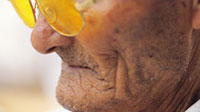 Facial changes naturally occur in relation to the aging process. When the teeth are lost, this process is grossly accelerated with
more rapid facial aging. The loss of teeth can add 10 or more years to a person's face. A decrease in face height occurs as a result
of the collapse of bone height when teeth are lost.
Skinner article no longer active.
Patients are often unaware that bone, gum and facial changes are due to the loss
of teeth. Instead, they blame these problems on aging, weight loss, or the dentist for making a poor denture.
Besides several facial changes, there are other consequences of losing teeth and not replacing them:
Facial changes naturally occur in relation to the aging process. When the teeth are lost, this process is grossly accelerated with
more rapid facial aging. The loss of teeth can add 10 or more years to a person's face. A decrease in face height occurs as a result
of the collapse of bone height when teeth are lost.
Skinner article no longer active.
Patients are often unaware that bone, gum and facial changes are due to the loss
of teeth. Instead, they blame these problems on aging, weight loss, or the dentist for making a poor denture.
Besides several facial changes, there are other consequences of losing teeth and not replacing them:
- jaw bone shrinks in height and width
- nearby teeth shift, move to fill missing tooth space
- sinus above upper jaw bone changes size --- may get thinner Gougaloff: Sinus Lift Procedure 2008
- change in facial features
- possible headaches and neck muscle tension
- May cause infection of other teeth
- possible link to sinus problems like nasal drip Gougaloff: Sinus Lift Procedure 2008
Many people, who lost teeth, upon later wanting to repair the damage caused by the loss of the tooth find that repair is much more expensive because of the movement in the adjacent and opposing teeth. Spiller article no longer active. Indeed, the changes to the jaw may be so great that fixing the damage may be very difficult or impossible .... and expensive!
Ways to deal with missing teeth:
- Dental implants
- Fixed bridge, also called fixed partial denture [FPD]
- Removable partial denture
- Other dental bridge types
- Stem cells in the future
What are dental implants?
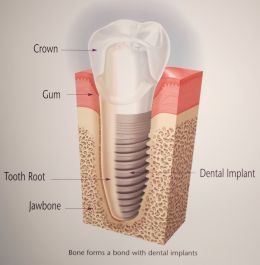
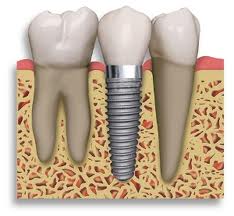
Dental implants [ illustration above ] are replacements for the roots of teeth, the parts that are below the gumline and anchored in bone. They are usually covered with a crown that shows above the line of the gums. Uditsky article no longer active, Spiller article no longer active. A primary reason to consider dental implants to replace missing teeth is the maintenance of jaw bone. As you may recall, bone needs stimulation to stay healthy. The implant takes the place of the missing tooth and stimulates the jaw bone to work normally. Misch: consequences losing teeth 2011 Bone resorption can be prevented by replacing natural teeth with dental implants soon after they are extracted. Key is soon!
Most importantly, implants reduce the amount of bone resorption. Studies have shown about 75% less resorption in parts of the jaw with implants compared to areas without them. Since most of the bone loss occurs within the first year after tooth loss, it is important to place implants within this time period. Uditsky: fixing loss teeth lower jaw 2012
"Up until now, the most common — but not necessarily the best — option for replacing a single back tooth has been a three-unit fixed partial denture (FPD), also called a fixed bridge. In this case, the two teeth on either side of the gap, known as abutment teeth, are crowned and the two crowns together support a “pontic” — a false tooth in the middle [from the French word for bridge].

This type of prosthesis [false replacement] can be fabricated within one to two weeks and provides normal shape, function [eating, talking and smiling], comfort, aesthetics and health. Because of these benefits, FPDs have been the treatment of choice. Misch: consequences losing teeth 2011
The bad side of doing a fixed bridge is that this procedure requires cutting down the healthy teeth on either side of the missing tooth. Tooth preparation of the adjacent teeth is irreversible and involves destroying quite a bit of tooth structure. Appleton: replacing missing teeth 2012 You and your dentist-orthodontist need to have a really good reason to do this procedure!
A well made fixed bridge can look natural, function well, and potentially last a lifetime. However, 75% of fixed bridges fail within 7 years. The fixed bridge is at least three teeth connected together with the false tooth (the replacement tooth) in the middle. Because the teeth are connected, you cannot pop dental floss between them. Instead you must thread the floss through underneath where the teeth are connected or use a special small brush to get under the connectors. People tend to neglect to perform this inconvenient extra step in their oral hygiene routine. This contributes to the relative high rate of failure of fixed bridges. Also, the extra stress on the teeth supporting the fixed bridge can lead to mechanical breakdown and thus adds to the failure rate. In spite of these potential problems, the fixed bridge is still the treatment of choice for many patients. Appleton: replacing missing teeth 2012
How Implants Stop Bone Loss: Dental implants fused and integrated into the jaw-bone serve as anchors to support teeth. They function the same as natural teeth in that the implant provides pressure stimulus on the opposite side tooth. As you may recall, bone needs stimulation to stay healthy. An implant-supported tooth, or teeth, allow for normal function of the whole jaw including the nerves, muscles and jaw joints. Moreover dental implants fuse to the bone, stabilizing and stimulating it to maintain its dimension and density. Misch: consequences losing teeth 2011
Missing teeth may cause sinus problems
Patients are often not quite clear that sinus problems may be related to missing teeth in the upper jaw and that these can be a very expensive fix.
The maxillary sinuses are behind your cheeks and on top of the upper teeth [ upper diagram ]. These sinuses are cavities with empty, air-filled spaces. Some of the roots of the natural upper teeth extend up into the maxillary sinuses. When teeth in the upper jaw are removed and not replaced, the jaw bone can shrivel up and the sinus will expand further down toward the jaw ridge from the inside of the jaw bone. This often causes a thin wall of bone separating the maxillary sinus and the mouth, making it difficult or impossible to place dental implants in the jaw bone. Young: Sinus Lift Gougaloff: Sinus Lift Procedure 2008
However, the thin jaw bone can be regrown and the thin sinus wall can be restored by a procedure known as "sinus lifting." This procedure strengthens the growing bone in the upper jaw, allowing dental implants to be placed in the new bone growth. This restores the missing teeth.
Finally, dental implants are now available in different sizes and length, making it more easy than in the past, to fix missing teeth in the jaw bones. You need to consult with your dental specialist for more information.
Is jaw bone loss reversible? Yes!
In cases where there is not enough bone to support a successful implant, the surgeon may perform a bone graft. A synthetic bone grafting compound may be used that is easier and more successful than bone on bone grafting. It can usually be done at the time of the implant surgery, allowing everything to heal into place together, which ultimately makes for a more solid implant.
Your dental health future is in dental stem cells:
Dentists are optimistic that stem cells will allow them to deliver more miraculous therapies that will benefit their patients and improve patient quality of life. The hope is that these dental stem cells could be used to heal the patients when they need it in the future. Research is now taking place about growing a bio-tooth, made from self-generated or self-produced [autogenous] Dental Pulp Stem Cells or DPSCs to regenerate lost teeth. DPSCs can be used in the same individual without the danger of an immune rejection response.
A dental study in 2009 used stem cells to heal jaw bone tissue. The stem cells come from a substance called dental pulp from within the interior chamber of our teeth. This pulp is made up of living soft tissue and stem cells. Dental stem cells are adult stem cells present in both baby (deciduous) teeth, and adult teeth. The stem cells consist of dental mesenchymal stem cells and dental epithelial cells. Dental epithelial cells give rise to enamel, while dental mesenchymal stem cells give rise to all of the other tissues of the tooth, including pulp, dentin, cementum, periodontal ligament, and surrounding alveolar bone. The ability to harvest cells from extracted wisdom teeth and supernumerary teeth that would otherwise be discarded as waste makes these tissues unique and valuable stem cell sources. Murray: latest dental stem cell 2012
A three month study, the first in dentistry, used dental stem cells to completely regenerate the injury site in the jaw and restore periodontal tissue. d’Aquino: stem cell healing in dentistry 2009 This study demonstrated that stem cells have great promise in helping to fix dental problems.
More recently in 2012, endodontics professor Dr. Peter Murray and colleagues from the College of Dental Medicine at Nova Southeastern University (NSU) have developed methods to control adult stem cell growth toward generating dental tissue and “real” replacement teeth. "Teeth can be grown separately, then inserted into a patient’s mouth, or the stem cells can be grown within the mouth, reaching a full-sized tooth within a few months. So far, teeth have been regenerated in mice and monkeys, and clinical trials with humans are underway, but whether the technology can generate teeth that are nourished by the blood and have full sensations remains to be seen." Hill: stem cells grow new teeth 2012
Why stem cells may be better than durable implants such as titanium dental implants? A short answer to this question is that stem cells lead to the regeneration of teeth with periodontal ligament that can remodel with the host. Mao elaborates on this concept of stem cell use:
"Stem cells can be seeded in biocompatible scaffolds in the shape of the anatomical structure that is to be replaced. Stem cells may elaborate and organize tissues in vivo, especially in the presence of vasculature. Finally, stem cells may regulate local and systemic immune reactions of the host in ways that favor tissue regeneration.
Much of what dentists know is evolving into a new dentistry in which dental care is delivered increasingly by biologically based approaches. For example, biomolecules will be used for periodontal regeneration; stem cells will be used in the regeneration of dentin and/or dental pulp; biologically viable scaffolds will be used to replace orofacial bone and cartilage; and the defective salivary gland will be partially or completed regenerated." Hill: stem cells grow new teeth 2012
So .... what do you do?
Using stem cells to safely regenerate missing teeth may be a few years in the future. Dentists predict that the technology should be available within the next decade. Hill: stem cells grow new teeth 2012 Meanwhile you should do the following:
1. Continue taking good care of your teeth-brushing and flossing regularly.
2. Pay immediate attention to missing teeth! Missing teeth are an overlooked item and need much more priority than brushing teeth because replacing lost teeth can prevent jaw bone loss and thereby keep your teeth and jaw bones healthy when you get older.
3. Be aware that dentistry is a business. Some dentists and prosthodontists may be more eager to have your money than fix your missing teeth!
4. Consider getting dental insurance if you have not done so. Today's available dental insurance coverage is better than none at all! Check to find out whether you have dental insurance coverage through your employer.
Some dental insurance plans may have an annual maximum benefit limit. Thus, once the annual maximum benefit is exhausted and additional treatments may become the patient's responsibility. Each year that annual maximum is reissued.
The problem with dental insurance is that companies selling dental insurance coverage have ceilings on how much dental insurance companies will cover, the kind of dental problems covered and so on; a form of rationing dental services. Many dental problems that occur in middle and senior stages of life; like replacing lost teeth, are expenses that the elderly cannot pay for and insurance companies place a limit on the amount they will pay. Unable to afford expensive fixes for loss of teeth, many elderly end up with continuing eating and jaw problems. It is the opinion of this author that we need a massive overhaul of the dental insurance system.
5. Make a partnership with your dentist so your dentist works for your health and that the partnership is a two-way street.This may be the new way of dentistry. In the past, many patients came to the dentist in pain and in need for immediate dental care. This 'one-way street' placed the patient in an uncompromising position of needing immediate dental care over dental information. Challenge your dentist!
6. Update your dentist with the information in this article .... to make him aware that you are an informed patient.
7. Check the references for some surprises.
Questions to ask:
Though one can easily find first-class experienced implant surgeons in some of the respected institutions, it is important to check the qualification, experience, profile and percentage of successful implant procedures of the implant surgeon you choose. You should never hesitate to ask any sort of questions related to your dental well-being in your next meeting:
What are your dental fix options? Have your dentist outline ALL of your options! For example, lose a tooth or save a tooth?
What kind of anesthetic will your dentist use: novocaine = trade name procaine Wiki: Procaine, lipocaine, mepivicane, lidocaine, bupiricane, demerol, other?
How big a dose will the anesthetic be? Is it related to body size?
How long will it take for the anesthetic to detoxify?
Are you allergic to the anesthetic? How does the dentist know?
What could potential side-effects be from the anesthetic? Nickel: toxicities from local anesthetics
What are the risks of a dental implant? or a root canal?
Why didn't your dentist prescribe a probiotic along with the antibiotic --- to restore the desirable good bacteria killed off by the antibiotic?
When was the last time your dentist went to a dental seminar or conference to update his background and skills?
Is there enough jaw bone to consider a dental implant? For example, it is important that you know everything related to the implant procedure much earlier than it happens.
Is your dentist going to get certified in dental stem cell surgery?
The author confesses that doing this article research about what should be new priorities in dentistry was not just informative but totally revealing. This author needed this information to be able to make better decisions about his own dental wellbeing. Sharing all this information in one location is done for your convenience. Hopefully you have become a little more informed about your dental health.
References:
American Academy of Peredontonology [AAP], "Dental Implant Placement Options," Perio.org. Article no konger active.
Appleton Richard, "What's the best way to replace a missing tooth or teeth?" HubPages, Explore »Health (33,263) »Oral Health (472), January 26, 2012. Appleton: replacing missing teeth 2012
Bubalo Marija, Zoran Lazić, Radomir Milović, Anika Ćuković, "Rehabilitation of Severely Resorbed Mandible Treated With Mini Dental Implants and Iliac Crest Bone Grafts: Case Report," Scientific Journal of the Faculty of Medicine in Niš 2011;28(3):183-188. Article no longer active.
"implant placement requires adequate bone quantity and quality." "More extreme cases require the implementation of bone grafts, autogenous, allogeneic, and xenogeneic, which has been documented as successful in many instances. Severely resorbed lower jaw requires the reconstruction with free bone grafts, vascularized grafts, or distraction osteogenesis. If a large amount of the bone has to be replaced, the grafts from the iliac bone, calvaria, or ribs are used." "the conclusion about the proper timing of implant placement is still far away."
Bhanumathi C.K, "Consequences Of Missing Teeth," WherincityMedical, October 22, 2009. Article no longer active.
Changes in the Jaw Bones, Teeth and Face after Tooth Loss, Images. Images of bone-dental changes
Cosmetic dentistry grants, Free dental implants. Dental Grants
d’Aquino R, A De Rosa, V Lanza, V Tirino, L Laino, A Graziano, V Desiderio, G Laino, G Papaccio, "Human mandible bone defect repair by the grafting of dental pulp stem/progenitor cells and collagen sponge biocomplexes," European Cells and Materials journal, November 12, 2009, Volume No 18 – pages 75-83. d’Aquino: stem cell healing in dentistry 2009 The first human study using dental stem cells in dentistry.
Dental Lab Direct, "Temporary Bridge," Temporary Bridge or TempoBridge® is now available for individuals that are in need of a false tooth for a short period of time. If you have a missing tooth, a bridge will be custom made to fill in the space with a false tooth; in the meantime, you may use a temporary bridge. This false tooth is attached within a clear retainer - bridging them together, sometimes called a flipper. The TempoBridge is designed for a short amount of time (5 months or less), cannot be used while eating, and can have only one, possibly two teeth. A better solution is the FLEXIBLE PARTIAL, it's well worth the additional dollars. Article mo longer active.
Gougaloff Robert, "Sinus Augmentation or Sinus Lift Procedure," Implant Laser Dentistry, September 10, 2008. Gougaloff: Sinus Lift Procedure 2008
Gougaloff Robert, "Stem Cells in Dentistry?" Implant Laser Dentistry, November 25, 2008. Gougaloff: stem cells 2008
"Absolutely !! Oral Surgery in general and bone grafting in particular are starting to make a transition. More and more bone grafting scenarios employ cell-based or growth factor-enhanced grafting material. Four items are absolutely essential in bone regeneration if predictable results are sought. •A matrix or scaffolding (collagen, bone mineral, synthetic grafts) •Cells (stem cells, platelets, osteoblasts) •Signaling molecules (growth factors, morphogens, adehsion molecules) •Time (often underestimated) "
Garisto Gabriella A., Andrew Gaffen, Herenia Lawrence, Howard Tenenbaum and Daniel Haas, “Occurrence of Paresthesia After Dental Local Anesthetic Administration in the United States,” Journal of American Dental Association, July 2010;141(7):836-844. Garisto: Paresthesia 2011
Hill David J., "Toothless No More – Researchers Using Stem Cells to Grow New Teeth," Singularity Hub, May 10th, 2012. Hill: stem cells grow new teeth 2012
Mao Jeremy J., "Stem Cells and the Future of Dental Care," NYSDJ, March, 2008. Article no longer active.
Misch Carl E., "The Hidden Consequences of Losing Teeth." Dear Doctor, August 1, 2011. How Dental Implants Stop Gradual Bone Loss and Replace Teeth Misch: consequences losing teeth 2011
Murray Peter E., BSc(Hons), PhD | Pamela C. Yelick, PhD | Thomas G.H. Diekwisch, "Question: What is the latest thinking in dental stem cell research?" Inside Dentistry, April 2012, Volume 8, Issue 4. Murray: latest dental stem cell 2012
National Dental Pulp Laboratory (NDPL), "Did you know there are Stem Cells in your teeth?" [ stores dental stem cells ]Article no longer active.
Nickel Alfred, "Aniline-Induced Toxicities from Local Anesthetics," See also Stockton article.Aricle no longer active.
"In 1994, direct evidence of local anesthetic metabolic conversion was presented to the Anesthetic and Life Support Drugs Advisory Committee for the Food and Drug Administration. When lidocaine was incubated with fresh human liver slices for four hours, 67% of the lidocaine was converted to its aniline homolog, 2,6-dimethylaniline, an established animal and probable human carcinogen 12,13. A second study published that same year demonstrated significantly elevated human hemoglobin adduct levels of 2,6-dimethylaniline in patients who had received lidocaine in accepted clinical treatment for cardiac problems 16. The FDA ruled that the package insert for EMLA, a dermatologic cream containing lidocaine and prilocaine, would contain this warning: "Metabolites of both lidocaine and prilocaine have been shown to be carcinogenic in animals...The [ortho-toluidine induced] tumors included hepatocarcinomas/adenomas in female mice, multiple occurences of hemangiosarcomas/ hemangiomas in both sexes of mice, sarcomas of multiple organs, transitional cell carcinomas/papillomas of urinary bladder in both sexes of rats, subcutaneous fibromas/ fibrosarcomas and mesotheliomas in male rats, and mammary gland fibroadenomas/adenomas in female rats. The lowest dose tested (900 mg/m ; 60 times SDA) was carcinogenic in both species. Thus the no effect dose must be less than 60 times SDA." 21.
Both the International Agency for Research on Cancer (IARC) and OSHA recommend a maximum long-term daily occupational exposure of skin and lungs to aniline homologs in humans of 10 mg per cubic meter 22,23. Twenty mg per cubic meter for short term exposure is acceptable by some standards 34. In routine clinical use of local anesthetics, the maximum recommended, daily occupational exposure level for anilines is frequently exceeded. Extensive, repetitious dental or medical care may maintain large aniline doses for prolonged intervals. Moreover, local anesthetics are adminstered by injection, giving direct access to the blood stream and bypassing the barriers of gastrointestinal absorption and hepatic detoxification. Stoichiometrically, I cc of 2% lidocaine produces 10 mg of 2,6-dimethylaniline with maximal hydrolysis 24. Surgeons will administer as much as 50 cc of 2% lidocaine (500 mg 2,6dimethylaniline) for a routine orthopedic procedure or a vein stripping. A dentist can inject 14 cc 2% lidocaine (140 mg 2,6-dimethylaniline) for the extraction of 4 third molars and 5-8 cc 2% lidocaine per weekIy or biweekIy session for up to 6 months for a full mouth reconstruction case (50-80 mg 2,.6-dimethylanitine each session or 1.2 - 3.8 g over a 6 month period)."
Skinner Michael, and Jason Primm, "Effects of Tooth Loss," 2008. Skinner: effects of tooth loss 20088 There is decreased performance of removable dentures.
Spiller Martin, "Bone Grafting 1 What is Bone Resorption?," DoctorSpiller.Com; An Encyclopedia of Dentistry, Copyright 2000. Spiller: index 2000
Steinberg Howard M., "Why Replace a Lost Tooth?" Howard M. Steinberg, March 26, 2011. Steinberg article no longer active.
Stockton Suzin, "Dangers of dental anesthetics," Issue #1 of Cavitations Plus Quarterly newsletter, 2004. (From Letters to the Editor, Issue #1 of Cavitations Plus Quarterly newsletter) In view of the suppressed information that has now surfaced regarding aniline toxicity, the widespread use of aniline-based local anesthetics in medicine and dentistry should be seriously reassessed. Stockton: 2004
"Breakdown products of many of the local anesthetics commonly used in dentistry are aggressively carcinogenic. Analines accumulate in and damage the bone marrow, causing anemia and depressed immune function."
"The amount of aniline resulting from routine clinical use of local anesthetics frequently exceeds the maximum recommended in daily occupational exposure (skin and lung exposure of 10 and 20 mg. per cubic meter in short and long-term exposure respectively). Only 1 cc of 2% lidocaine produces 10 mg. of 2, 6-dimethylaniline. A dentist may inject as much as 14 cc of lidocaine when doing an extraction. This amounts to 140 mg. of 2, 6 dimethylaniline. Considering that one unfiltered cigarette contains 102 nanograms of 2,6-dimethylaniline, "It would be necessary to smoke a pack of unfiltered cigarettes a day for approximately 12.9 years to inhale an equivalent amount of 2,6-dimethylaniline to that injected in a single cc of 2% lidocaine," according to Nickel. "
The Dental Learning Network, "Chapter Nine - Toxicity," Dose calculation. Article no longer active. "Local anesthetics are linked to 50% of the deaths in the dental office. Use the smallest dose that will produce adequate anesthesia. The rate of absorption and elimination of the drug is directly related to its toxic effects. The faster it is absorbed by the bloodstream and the slower the metabolism of the drug, the more toxic it is to the body.
Uditsky Daniel N., "Solution for Loss of Teeth in the Lower Jaw," June 14, 2012. Uditsky article no longer active.
WebMD, "An Overview of Root Canals." WebMD: root canals
Wikipedia, "Dental technician." Wiki: dental tech
Wikipedia, "Procaine." Wiki: Procaine Procaine , a trade name for Novocaine, can also cause allergic reactions causing the individuals to have problems with breathing, rashes, and swelling. Allergic reactions to procaine are usually not in response to procaine itself, but to its metabolite PABA. About 1 in 3000 people have an atypical form of pseudocholinesterase, which does not hydrolyze ester anesthetics such as procaine, resulting in a prolonged period of high levels of the anesthetic in the blood and increased toxicity.
Young Roland I., "Sinus Lift," Oral Surgery and dental Implants. Modesto, Ca.. Young: Sinus Lift
